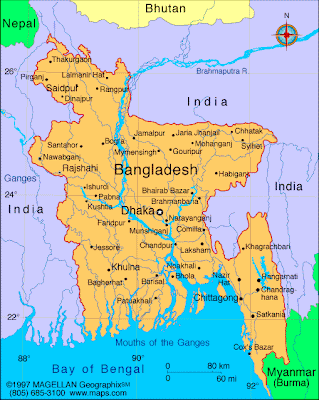 |
| National bird of Bangladesh |
Climate:
The climate of a place is dependent on its latitudes, altitude, temperature and rainfall. Mangoes are grown commercially within an area roughly 30 degree north to 30 degree south latitude. Bangladesh is situated between 20.5 degree to 26.5 degree north latitude. The mango is in general a tropical fruit that grows in the sub-tropical zone too and grows up to an altitude of 4600 feet (1400m) provided there is no high humidity, rain or frost during the flowering period . So, the range of latitude and altitude in Bangladesh is basically good for mango .It does well within a temperature range from 24 to 27 degree centigrade. Bangladesh’s overall mean annual temperature of 18 to 30 degree centigrade, which is quite good for mango production. The amount of rainfall is not so important factor as its intensity and distribution. It can do well in areas having an average rainfall as low as 25 cm to as high as 250 cm. The period of preceding flowering needs to be dry in order to induce flowering in the absence of chilling temperature.
Soil:
Mangoes can be grown on a wide range of soil type, but well drainage deep, fertile loamy soil of high to medium high land is best. pH 5.5-7.5 and water table below 180 cm around the year.
Land preparation:
Mango plantation are made on the selected site after cleaning the land of all wild growth, weeds etc. The seedling/sapling are planted generally during the rains in pit made well-leveled areas.
Planting system:
Square or rectangular for plain land and contour system for hilly areas. One year old seedling obtained through vegetative propagation that are strong , stout, and free from any diseases should be planted.
Propagation:
Mango can be raised from seed or vegetatively propagated. Seed propagation is now restricted to raising rootstocks, which are not true to type. To raise rootstock , freshly extracted stones from mature and ripe fruits are sown in beds in lines. These seedlings remain there for a year. When they attain a suitable thickness and height they are propagated asexually by side or veneer either in beds or shifted to a suitable seized earthen or polythene bags and grafted by inarching.
Time of planting:
Mid May to mid July is the best period for planting and mid August to mid October is also good.
Distance:
Planting distance depends upon soil, variety, climate and system of orchard management. However under good management the planting distance for tall varieties 10-12 meters and the dwarf varieties require only 2.5 to 3 meters between the plants and rows 8-10 meters.
Size of pit:
1.0 m*1.0 m*1.0 m.
Manures and Fertilizers:
Manures/Fertilizers
|
Amount in each pit
|
Organic manures
|
18-22 kg
|
Urea
|
100-200 g
|
TSP
|
450-550 g
|
MP
|
200-300 g
|
Gypsum
|
200-300 g
|
Zinc Sulphate
|
40-60 g
|
Seedlings planting:
Seedlings should be planted with the soil ball intact at middle of the pit straightly after 10-15 days of filling the pit. After planting , the seedling should be provided with proper fencing, sticks etc.
Fertilizer application:
Yearly recommended fertilizers for a mature and fruiting trees are:
Manures/Fertilizers
|
Amount per plant
|
Organic manure
|
50.0 kg
|
Urea
|
2.0 kg
|
TSP
|
1.0 kg
|
MP
|
500 g
|
Gypsum
|
500 g
|
Zinc sulphate
|
25 g
|
The fertilizers should be applied into two equal split:one in mid May to mid July and other in mid September to mid October.
Irrigation:
Frequent irrigation is needed for fast growth of seedlings. The need for irrigation will arise during the drier part of the year from November to April and lesser in Summer(May-June). In the bearings trees, one irrigation at the later part of flowering and one irrigation at fruit setting stage(when the fruits are in a pea stage) will be needed. Basin system is best for irrigation.
Pruning:
Mango has no specific pruning schedule, except when trees are young to give them a good shape. All side shoots should be pruned upto a height of 1.0-1.5 m of the main stem. All the inflorescences should also be pruned upto 4 years of the seedlings age.
Intercultural operation;
Intercultural operation of the mango orchard is necessary not only to remove the weeds which compete for water and nutrients but also to ensure aeration which is essential for the proper development root and shoot. Intercultural operation may help in reducing the pest population by killing them physically.
Maturity indices:
Appearance of wax coating, dots on the fruits, relative size of the fruits are some of the external appearances of the fruits which indicate maturity. However some ripened fruits when start dropping.it is said that maturity of that particular variety is reached.
Harvesting:
Mango fruits are rarely allowed to ripen on trees .Fruits may be harvested at the time when they show a slight yellowish color around the fruit stalk or when the specific gravity reaches 1.01 to 1.02 or when naturally one or two ripe fruits start dropping from the plant.Mango should be harvested without any injury. Generally fruits with stalk intact are harvested by hand or with the help of a bag affixed on along pole from the tall trees.
Yield:
The yield of mango varies with the variety, productivity of flowering , growing condition influencing the size of the plants etc. The young trees, in the beginning, bear 15 to 20 fruits per year which increases to an average of 400 to 600 fruits in the 10thyear and to 2500-5000 fruits per tree after 20th year. The average fruit production in Bangladesh is 4.76 t/ha which is quite low compared to India (8-10 t/ha) as well as to the world production of 14-16 t/ha.
Diseases:
1 .Leaf spot disease
2. Red rust disease
3. Red leaf spot disease
4. Blight
6. Anthracnose/die-back
7. Powdery mildew disease
8. Sooty mold disease
9. Scab disease
10. Malformation
11. Fruit rot
12. Loranthus
Insects:
1. Mango hopper
2. Shoot-gall Psyllid of mango
3. Mango fruit weevil
4. Mango fruit fly
5. Mango defoliator
6. Mango stem borer
7. Mango leaf gall-forming insects
SPECIAL PROBLEM:
Malformation :
Malformation is a serious threat to mango production. It affects both the vegetative parts and the inflorescence. Malformed branches show stunted growth , with small and bunchy leaves; this disorder is thus called bunchy top. Most of the flowers on malformed inflorescences are male and fruit is hardly ever obtained from them. The cause is not yet known but viruses, fungi, mites and deficiency of element have all been considered as possible causes. Good management reduces the problem to some extent.
Alternate bearing:
Most of the commercial varieties of mango tend to produce crops in an alternate or biennial patter. Alternate bearing in fruit trees is the habit of bearing heavily in one year called the on year and very little or not all in the second year called the off year. The factors affecting it are environmental, physiological and genetic.











